Health Management Information System Analysis Report
VerifiedAdded on 2020/03/15
|6
|1567
|197
Report
AI Summary
This report provides an analysis of the Health Management Information System (HMIS), focusing on the importance of CIO surveys in understanding industry trends and challenges. It explores the hardware investments required for HMIS, emphasizing the need for strong and reliable IT infrastructure, including electronic record systems and robust internet connectivity. The report highlights the significance of Electronic Health Records (EHR) investment programs, driven by the automation of healthcare practices and the HITECH Act. It contrasts the priorities of clinic/group practice workers with those of hospital/integrated delivery system workers regarding backup and disaster recovery plans, suggesting differences in their approach to data security and patient information management. The report concludes by emphasizing the importance of IT as an integral part of the HMIS for its future success.

1
Running Head: SPIRITUAL NEEDS ASSEESMENT
Spiritual Needs Assessment
Institution
Lecturer
Student
Course
Date
Running Head: SPIRITUAL NEEDS ASSEESMENT
Spiritual Needs Assessment
Institution
Lecturer
Student
Course
Date
Paraphrase This Document
Need a fresh take? Get an instant paraphrase of this document with our AI Paraphraser
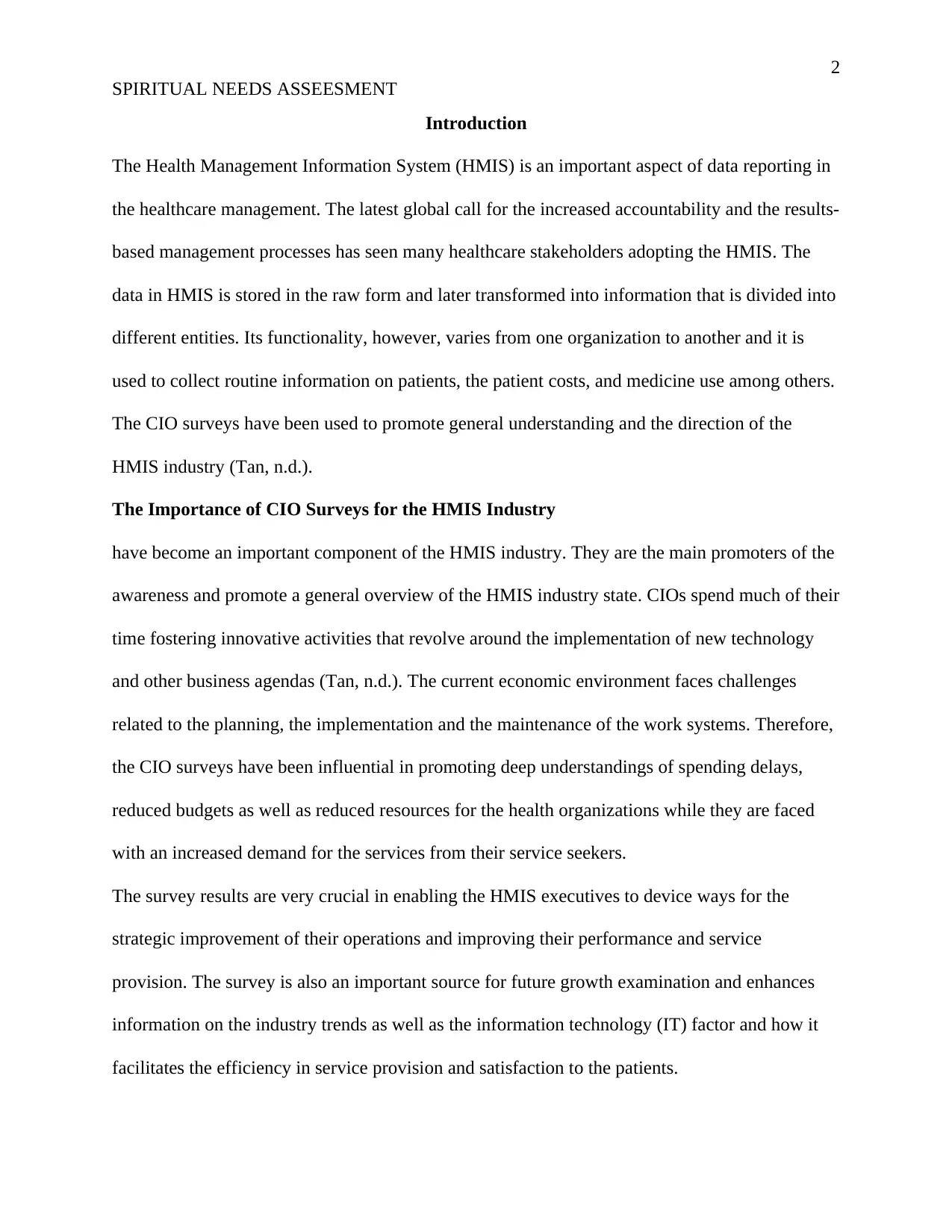
2
SPIRITUAL NEEDS ASSEESMENT
Introduction
The Health Management Information System (HMIS) is an important aspect of data reporting in
the healthcare management. The latest global call for the increased accountability and the results-
based management processes has seen many healthcare stakeholders adopting the HMIS. The
data in HMIS is stored in the raw form and later transformed into information that is divided into
different entities. Its functionality, however, varies from one organization to another and it is
used to collect routine information on patients, the patient costs, and medicine use among others.
The CIO surveys have been used to promote general understanding and the direction of the
HMIS industry (Tan, n.d.).
The Importance of CIO Surveys for the HMIS Industry
have become an important component of the HMIS industry. They are the main promoters of the
awareness and promote a general overview of the HMIS industry state. CIOs spend much of their
time fostering innovative activities that revolve around the implementation of new technology
and other business agendas (Tan, n.d.). The current economic environment faces challenges
related to the planning, the implementation and the maintenance of the work systems. Therefore,
the CIO surveys have been influential in promoting deep understandings of spending delays,
reduced budgets as well as reduced resources for the health organizations while they are faced
with an increased demand for the services from their service seekers.
The survey results are very crucial in enabling the HMIS executives to device ways for the
strategic improvement of their operations and improving their performance and service
provision. The survey is also an important source for future growth examination and enhances
information on the industry trends as well as the information technology (IT) factor and how it
facilitates the efficiency in service provision and satisfaction to the patients.
SPIRITUAL NEEDS ASSEESMENT
Introduction
The Health Management Information System (HMIS) is an important aspect of data reporting in
the healthcare management. The latest global call for the increased accountability and the results-
based management processes has seen many healthcare stakeholders adopting the HMIS. The
data in HMIS is stored in the raw form and later transformed into information that is divided into
different entities. Its functionality, however, varies from one organization to another and it is
used to collect routine information on patients, the patient costs, and medicine use among others.
The CIO surveys have been used to promote general understanding and the direction of the
HMIS industry (Tan, n.d.).
The Importance of CIO Surveys for the HMIS Industry
have become an important component of the HMIS industry. They are the main promoters of the
awareness and promote a general overview of the HMIS industry state. CIOs spend much of their
time fostering innovative activities that revolve around the implementation of new technology
and other business agendas (Tan, n.d.). The current economic environment faces challenges
related to the planning, the implementation and the maintenance of the work systems. Therefore,
the CIO surveys have been influential in promoting deep understandings of spending delays,
reduced budgets as well as reduced resources for the health organizations while they are faced
with an increased demand for the services from their service seekers.
The survey results are very crucial in enabling the HMIS executives to device ways for the
strategic improvement of their operations and improving their performance and service
provision. The survey is also an important source for future growth examination and enhances
information on the industry trends as well as the information technology (IT) factor and how it
facilitates the efficiency in service provision and satisfaction to the patients.
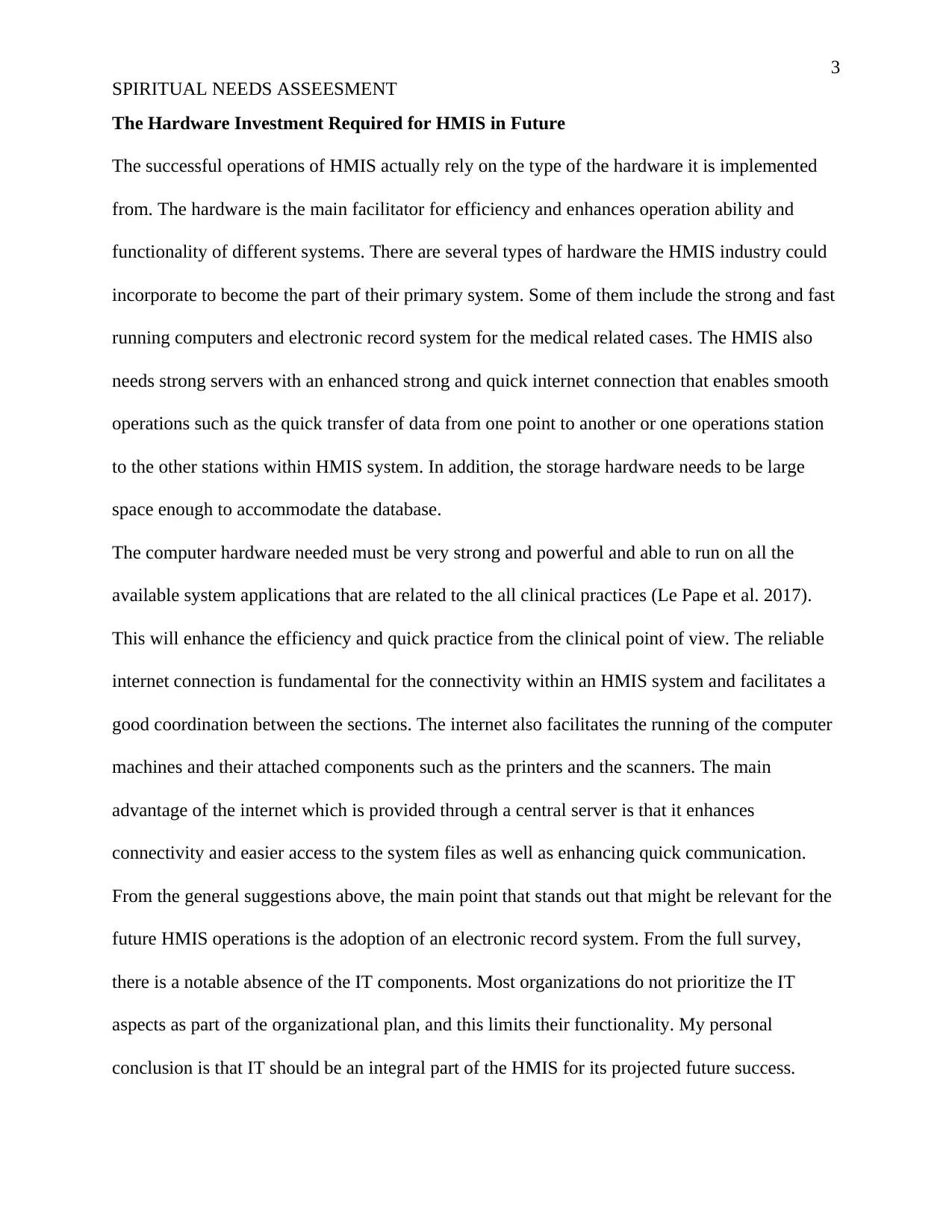
3
SPIRITUAL NEEDS ASSEESMENT
The Hardware Investment Required for HMIS in Future
The successful operations of HMIS actually rely on the type of the hardware it is implemented
from. The hardware is the main facilitator for efficiency and enhances operation ability and
functionality of different systems. There are several types of hardware the HMIS industry could
incorporate to become the part of their primary system. Some of them include the strong and fast
running computers and electronic record system for the medical related cases. The HMIS also
needs strong servers with an enhanced strong and quick internet connection that enables smooth
operations such as the quick transfer of data from one point to another or one operations station
to the other stations within HMIS system. In addition, the storage hardware needs to be large
space enough to accommodate the database.
The computer hardware needed must be very strong and powerful and able to run on all the
available system applications that are related to the all clinical practices (Le Pape et al. 2017).
This will enhance the efficiency and quick practice from the clinical point of view. The reliable
internet connection is fundamental for the connectivity within an HMIS system and facilitates a
good coordination between the sections. The internet also facilitates the running of the computer
machines and their attached components such as the printers and the scanners. The main
advantage of the internet which is provided through a central server is that it enhances
connectivity and easier access to the system files as well as enhancing quick communication.
From the general suggestions above, the main point that stands out that might be relevant for the
future HMIS operations is the adoption of an electronic record system. From the full survey,
there is a notable absence of the IT components. Most organizations do not prioritize the IT
aspects as part of the organizational plan, and this limits their functionality. My personal
conclusion is that IT should be an integral part of the HMIS for its projected future success.
SPIRITUAL NEEDS ASSEESMENT
The Hardware Investment Required for HMIS in Future
The successful operations of HMIS actually rely on the type of the hardware it is implemented
from. The hardware is the main facilitator for efficiency and enhances operation ability and
functionality of different systems. There are several types of hardware the HMIS industry could
incorporate to become the part of their primary system. Some of them include the strong and fast
running computers and electronic record system for the medical related cases. The HMIS also
needs strong servers with an enhanced strong and quick internet connection that enables smooth
operations such as the quick transfer of data from one point to another or one operations station
to the other stations within HMIS system. In addition, the storage hardware needs to be large
space enough to accommodate the database.
The computer hardware needed must be very strong and powerful and able to run on all the
available system applications that are related to the all clinical practices (Le Pape et al. 2017).
This will enhance the efficiency and quick practice from the clinical point of view. The reliable
internet connection is fundamental for the connectivity within an HMIS system and facilitates a
good coordination between the sections. The internet also facilitates the running of the computer
machines and their attached components such as the printers and the scanners. The main
advantage of the internet which is provided through a central server is that it enhances
connectivity and easier access to the system files as well as enhancing quick communication.
From the general suggestions above, the main point that stands out that might be relevant for the
future HMIS operations is the adoption of an electronic record system. From the full survey,
there is a notable absence of the IT components. Most organizations do not prioritize the IT
aspects as part of the organizational plan, and this limits their functionality. My personal
conclusion is that IT should be an integral part of the HMIS for its projected future success.
⊘ This is a preview!⊘
Do you want full access?
Subscribe today to unlock all pages.

Trusted by 1+ million students worldwide
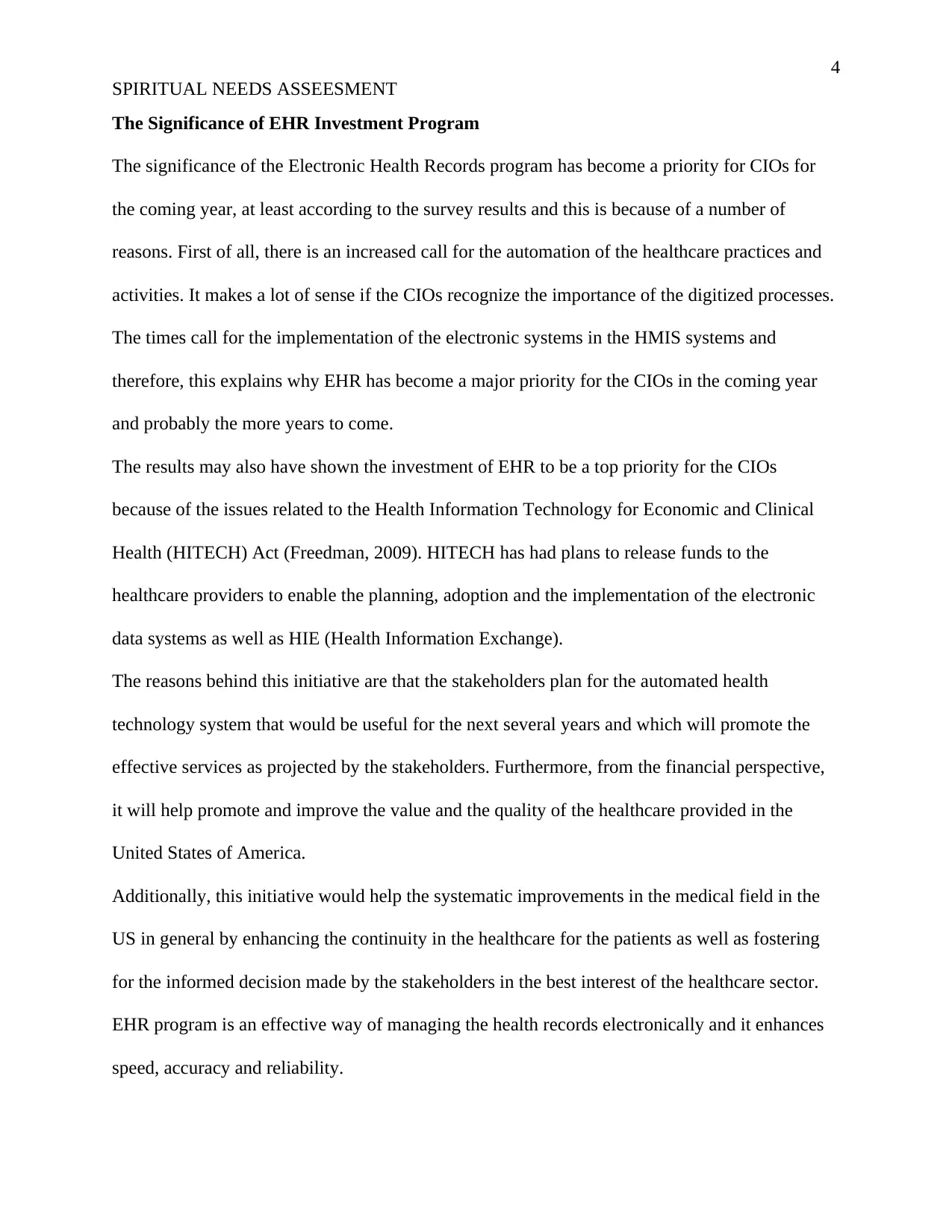
4
SPIRITUAL NEEDS ASSEESMENT
The Significance of EHR Investment Program
The significance of the Electronic Health Records program has become a priority for CIOs for
the coming year, at least according to the survey results and this is because of a number of
reasons. First of all, there is an increased call for the automation of the healthcare practices and
activities. It makes a lot of sense if the CIOs recognize the importance of the digitized processes.
The times call for the implementation of the electronic systems in the HMIS systems and
therefore, this explains why EHR has become a major priority for the CIOs in the coming year
and probably the more years to come.
The results may also have shown the investment of EHR to be a top priority for the CIOs
because of the issues related to the Health Information Technology for Economic and Clinical
Health (HITECH) Act (Freedman, 2009). HITECH has had plans to release funds to the
healthcare providers to enable the planning, adoption and the implementation of the electronic
data systems as well as HIE (Health Information Exchange).
The reasons behind this initiative are that the stakeholders plan for the automated health
technology system that would be useful for the next several years and which will promote the
effective services as projected by the stakeholders. Furthermore, from the financial perspective,
it will help promote and improve the value and the quality of the healthcare provided in the
United States of America.
Additionally, this initiative would help the systematic improvements in the medical field in the
US in general by enhancing the continuity in the healthcare for the patients as well as fostering
for the informed decision made by the stakeholders in the best interest of the healthcare sector.
EHR program is an effective way of managing the health records electronically and it enhances
speed, accuracy and reliability.
SPIRITUAL NEEDS ASSEESMENT
The Significance of EHR Investment Program
The significance of the Electronic Health Records program has become a priority for CIOs for
the coming year, at least according to the survey results and this is because of a number of
reasons. First of all, there is an increased call for the automation of the healthcare practices and
activities. It makes a lot of sense if the CIOs recognize the importance of the digitized processes.
The times call for the implementation of the electronic systems in the HMIS systems and
therefore, this explains why EHR has become a major priority for the CIOs in the coming year
and probably the more years to come.
The results may also have shown the investment of EHR to be a top priority for the CIOs
because of the issues related to the Health Information Technology for Economic and Clinical
Health (HITECH) Act (Freedman, 2009). HITECH has had plans to release funds to the
healthcare providers to enable the planning, adoption and the implementation of the electronic
data systems as well as HIE (Health Information Exchange).
The reasons behind this initiative are that the stakeholders plan for the automated health
technology system that would be useful for the next several years and which will promote the
effective services as projected by the stakeholders. Furthermore, from the financial perspective,
it will help promote and improve the value and the quality of the healthcare provided in the
United States of America.
Additionally, this initiative would help the systematic improvements in the medical field in the
US in general by enhancing the continuity in the healthcare for the patients as well as fostering
for the informed decision made by the stakeholders in the best interest of the healthcare sector.
EHR program is an effective way of managing the health records electronically and it enhances
speed, accuracy and reliability.
Paraphrase This Document
Need a fresh take? Get an instant paraphrase of this document with our AI Paraphraser
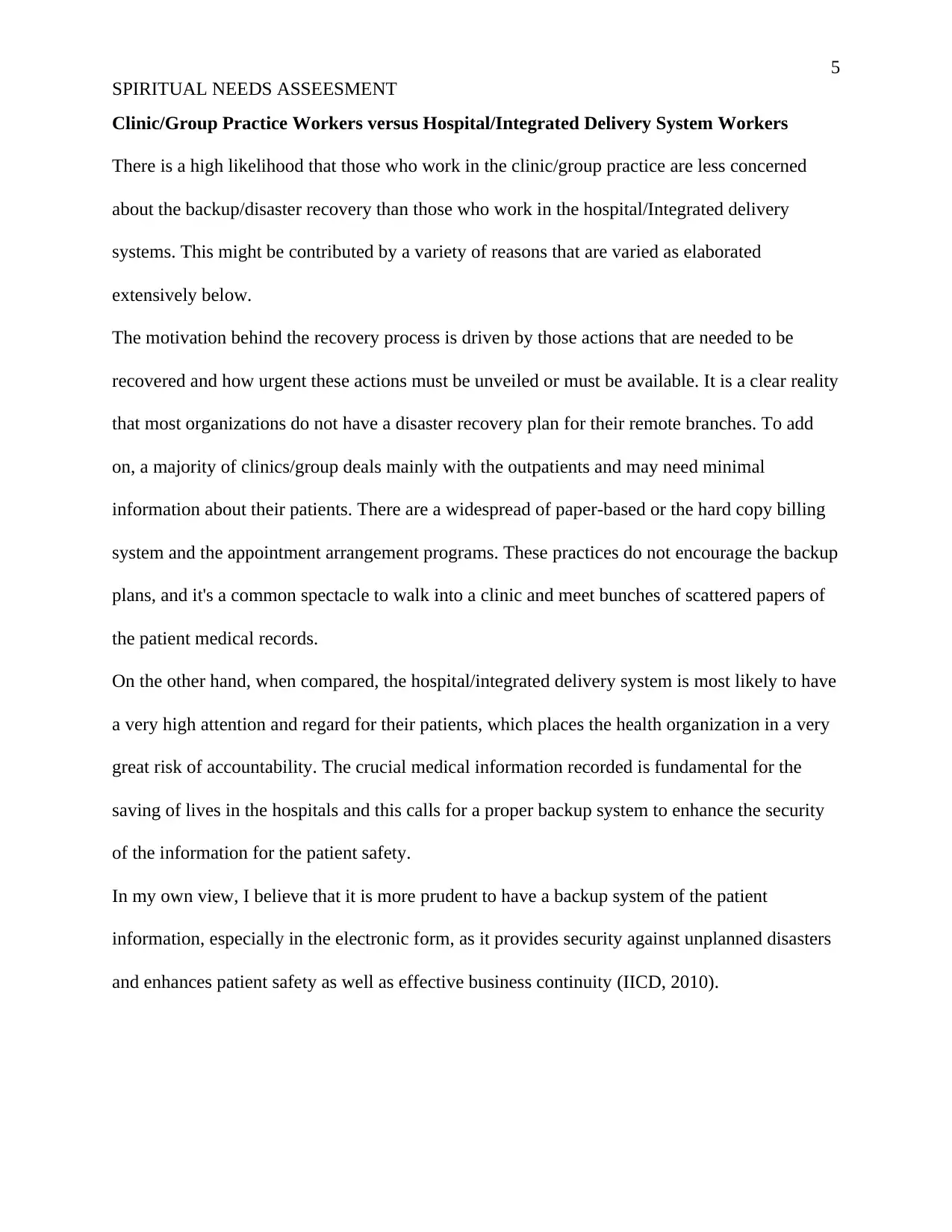
5
SPIRITUAL NEEDS ASSEESMENT
Clinic/Group Practice Workers versus Hospital/Integrated Delivery System Workers
There is a high likelihood that those who work in the clinic/group practice are less concerned
about the backup/disaster recovery than those who work in the hospital/Integrated delivery
systems. This might be contributed by a variety of reasons that are varied as elaborated
extensively below.
The motivation behind the recovery process is driven by those actions that are needed to be
recovered and how urgent these actions must be unveiled or must be available. It is a clear reality
that most organizations do not have a disaster recovery plan for their remote branches. To add
on, a majority of clinics/group deals mainly with the outpatients and may need minimal
information about their patients. There are a widespread of paper-based or the hard copy billing
system and the appointment arrangement programs. These practices do not encourage the backup
plans, and it's a common spectacle to walk into a clinic and meet bunches of scattered papers of
the patient medical records.
On the other hand, when compared, the hospital/integrated delivery system is most likely to have
a very high attention and regard for their patients, which places the health organization in a very
great risk of accountability. The crucial medical information recorded is fundamental for the
saving of lives in the hospitals and this calls for a proper backup system to enhance the security
of the information for the patient safety.
In my own view, I believe that it is more prudent to have a backup system of the patient
information, especially in the electronic form, as it provides security against unplanned disasters
and enhances patient safety as well as effective business continuity (IICD, 2010).
SPIRITUAL NEEDS ASSEESMENT
Clinic/Group Practice Workers versus Hospital/Integrated Delivery System Workers
There is a high likelihood that those who work in the clinic/group practice are less concerned
about the backup/disaster recovery than those who work in the hospital/Integrated delivery
systems. This might be contributed by a variety of reasons that are varied as elaborated
extensively below.
The motivation behind the recovery process is driven by those actions that are needed to be
recovered and how urgent these actions must be unveiled or must be available. It is a clear reality
that most organizations do not have a disaster recovery plan for their remote branches. To add
on, a majority of clinics/group deals mainly with the outpatients and may need minimal
information about their patients. There are a widespread of paper-based or the hard copy billing
system and the appointment arrangement programs. These practices do not encourage the backup
plans, and it's a common spectacle to walk into a clinic and meet bunches of scattered papers of
the patient medical records.
On the other hand, when compared, the hospital/integrated delivery system is most likely to have
a very high attention and regard for their patients, which places the health organization in a very
great risk of accountability. The crucial medical information recorded is fundamental for the
saving of lives in the hospitals and this calls for a proper backup system to enhance the security
of the information for the patient safety.
In my own view, I believe that it is more prudent to have a backup system of the patient
information, especially in the electronic form, as it provides security against unplanned disasters
and enhances patient safety as well as effective business continuity (IICD, 2010).
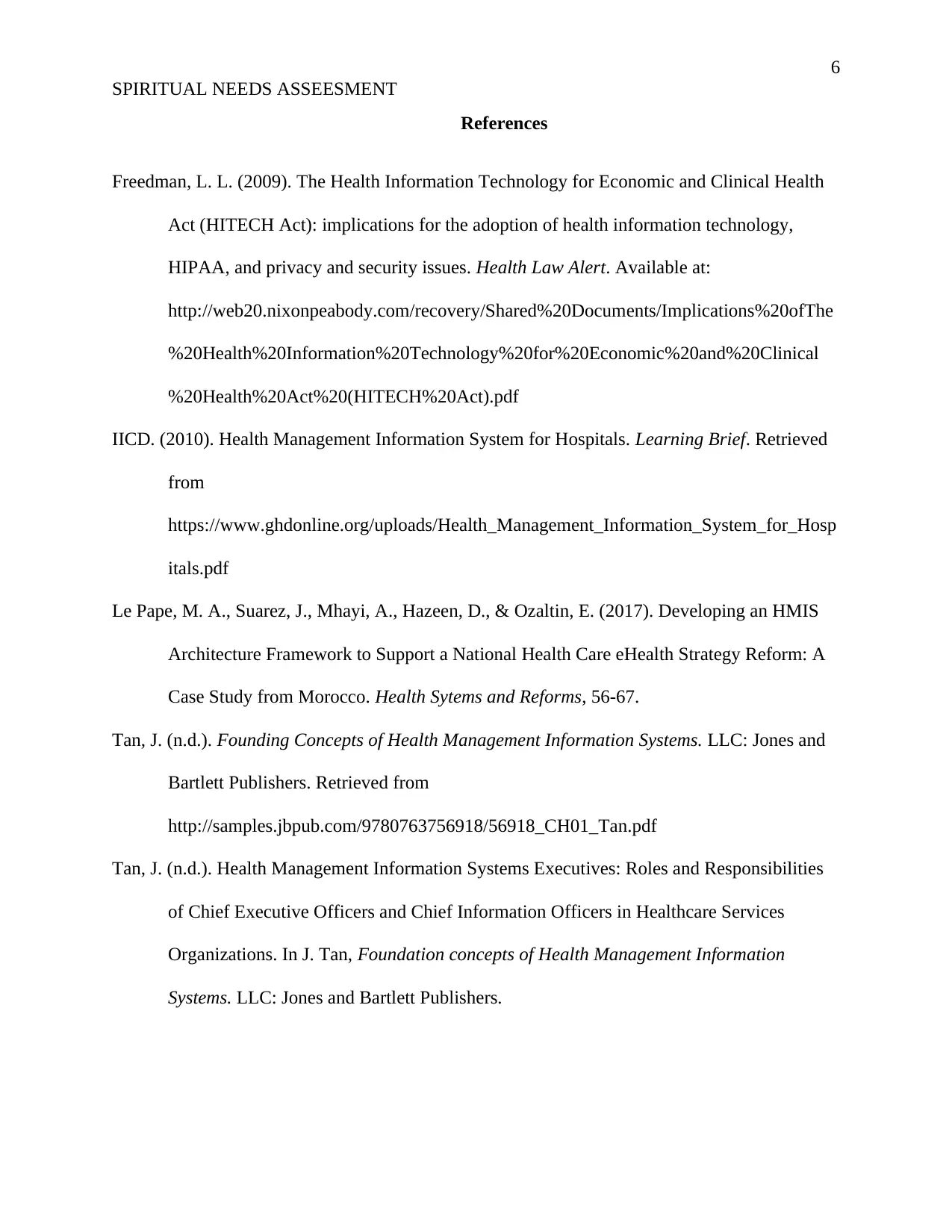
6
SPIRITUAL NEEDS ASSEESMENT
References
Freedman, L. L. (2009). The Health Information Technology for Economic and Clinical Health
Act (HITECH Act): implications for the adoption of health information technology,
HIPAA, and privacy and security issues. Health Law Alert. Available at:
http://web20.nixonpeabody.com/recovery/Shared%20Documents/Implications%20ofThe
%20Health%20Information%20Technology%20for%20Economic%20and%20Clinical
%20Health%20Act%20(HITECH%20Act).pdf
IICD. (2010). Health Management Information System for Hospitals. Learning Brief. Retrieved
from
https://www.ghdonline.org/uploads/Health_Management_Information_System_for_Hosp
itals.pdf
Le Pape, M. A., Suarez, J., Mhayi, A., Hazeen, D., & Ozaltin, E. (2017). Developing an HMIS
Architecture Framework to Support a National Health Care eHealth Strategy Reform: A
Case Study from Morocco. Health Sytems and Reforms, 56-67.
Tan, J. (n.d.). Founding Concepts of Health Management Information Systems. LLC: Jones and
Bartlett Publishers. Retrieved from
http://samples.jbpub.com/9780763756918/56918_CH01_Tan.pdf
Tan, J. (n.d.). Health Management Information Systems Executives: Roles and Responsibilities
of Chief Executive Officers and Chief Information Officers in Healthcare Services
Organizations. In J. Tan, Foundation concepts of Health Management Information
Systems. LLC: Jones and Bartlett Publishers.
SPIRITUAL NEEDS ASSEESMENT
References
Freedman, L. L. (2009). The Health Information Technology for Economic and Clinical Health
Act (HITECH Act): implications for the adoption of health information technology,
HIPAA, and privacy and security issues. Health Law Alert. Available at:
http://web20.nixonpeabody.com/recovery/Shared%20Documents/Implications%20ofThe
%20Health%20Information%20Technology%20for%20Economic%20and%20Clinical
%20Health%20Act%20(HITECH%20Act).pdf
IICD. (2010). Health Management Information System for Hospitals. Learning Brief. Retrieved
from
https://www.ghdonline.org/uploads/Health_Management_Information_System_for_Hosp
itals.pdf
Le Pape, M. A., Suarez, J., Mhayi, A., Hazeen, D., & Ozaltin, E. (2017). Developing an HMIS
Architecture Framework to Support a National Health Care eHealth Strategy Reform: A
Case Study from Morocco. Health Sytems and Reforms, 56-67.
Tan, J. (n.d.). Founding Concepts of Health Management Information Systems. LLC: Jones and
Bartlett Publishers. Retrieved from
http://samples.jbpub.com/9780763756918/56918_CH01_Tan.pdf
Tan, J. (n.d.). Health Management Information Systems Executives: Roles and Responsibilities
of Chief Executive Officers and Chief Information Officers in Healthcare Services
Organizations. In J. Tan, Foundation concepts of Health Management Information
Systems. LLC: Jones and Bartlett Publishers.
⊘ This is a preview!⊘
Do you want full access?
Subscribe today to unlock all pages.

Trusted by 1+ million students worldwide
1 out of 6
Related Documents
Your All-in-One AI-Powered Toolkit for Academic Success.
+13062052269
info@desklib.com
Available 24*7 on WhatsApp / Email
![[object Object]](/_next/static/media/star-bottom.7253800d.svg)
Unlock your academic potential
Copyright © 2020–2025 A2Z Services. All Rights Reserved. Developed and managed by ZUCOL.




